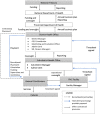Emergence of three general practitioner contracting-in models in South Africa: a qualitative multi-case study
- PMID: 30286772
- PMCID: PMC6172712
- DOI: 10.1186/s12939-018-0830-0
Emergence of three general practitioner contracting-in models in South Africa: a qualitative multi-case study
Abstract
Background: The general practitioner contracting initiative (GPCI) is a health systems strengthening initiative piloted in the first phase of national health insurance (NHI) implementation in South Africa as it progresses towards universal health coverage (UHC). GPCI aimed to address the shortage of doctors in the public sector by contracting-in private sector general practitioners (GPs) to render services in public primary health care clinics. This paper explores the early inception and emergence of the GPCI. It describes three models of contracting-in that emerged and interrogates key factors influencing their evolution.
Methods: This qualitative multi-case study draws on three cases. Data collection comprised document review, key informant interviews and focus group discussions with national, provincial and district managers as well as GPs (n = 68). Walt and Gilson's health policy analysis triangle and Liu's conceptual framework on contracting-out were used to explore the policy content, process, actors and contractual arrangements involved.
Results: Three models of contracting-in emerged, based on the type of purchaser: a centralized-purchaser model, a decentralized-purchaser model and a contracted-purchaser model. These models are funded from a single central source but have varying levels of involvement of national, provincial and district managers. Funds are channelled from purchaser to provider in slightly different ways. Contract formality differed slightly by model and was found to be influenced by context and type of purchaser. Conceptualization of the GPCI was primarily a nationally-driven process in a context of high-level political will to address inequity through NHI implementation. Emergence of the models was influenced by three main factors, flexibility in the piloting process, managerial capacity and financial management capacity.
Conclusion: The GPCI models were iterations of the centralized-purchaser model. Emergence of the other models was strongly influenced by purchaser capacity to manage contracts, payments and recruitment processes. Findings from the decentralized-purchaser model show importance of local context, provincial capacity and experience on influencing evolution of the models. Whilst contract characteristics need to be well defined, allowing for adaptability to the local context and capacity is critical. Purchaser capacity, existing systems and institutional knowledge and experience in contracting and financial management should be considered before adopting a decentralized implementation approach.
Keywords: Contracting; Contracting-in; General practitioner; Health policy and systems research; Low-and-middle-income countries; Non-state provider; Primary health care; Public private sector; South Africa; Universal health care.
Conflict of interest statement
Ethics approval and consent to participate
Ethical approval for the study was obtained from the University of Cape Town Human Research Ethics Committee (HREC 189/2015) and WHO Ethics Review Committee (ERC.0002661). All participants provided informed consent prior to data collection.
Consent for publication
Consent for publication was obtained from all participants.
Competing interests
The authors declare they have no competing interests.
Publisher’s Note
Springer Nature remains neutral with regard to jurisdictional claims in published maps and institutional affiliations.
Figures



Similar articles
-
Models using private general practitioners to provide caesarean deliveries at five South African district public hospitals: insights for public-private contracting for obstetric care in rural areas.Glob Health Action. 2023 Dec 31;16(1):2241811. doi: 10.1080/16549716.2023.2241811. Glob Health Action. 2023. PMID: 37552135 Free PMC article.
-
Contracting-out primary health care services in Tanzania towards UHC: how policy processes and context influence policy design and implementation.Int J Equity Health. 2018 Oct 5;17(1):118. doi: 10.1186/s12939-018-0835-8. Int J Equity Health. 2018. PMID: 30286767 Free PMC article.
-
The views of public service managers on the implementation of National Health Insurance in primary care: a case of Johannesburg Health District, Gauteng Province, Republic of South Africa.BMC Health Serv Res. 2021 Sep 15;21(1):969. doi: 10.1186/s12913-021-06990-4. BMC Health Serv Res. 2021. PMID: 34521399 Free PMC article.
-
Achieving universal health coverage in South Africa through a district health system approach: conflicting ideologies of health care provision.BMC Health Serv Res. 2016 Oct 7;16(1):558. doi: 10.1186/s12913-016-1797-4. BMC Health Serv Res. 2016. PMID: 27717353 Free PMC article. Review.
-
Examining healthcare purchasing arrangements for strategic purchasing in Nigeria: a case study of the Imo state healthcare system.Health Res Policy Syst. 2022 Apr 18;20(1):41. doi: 10.1186/s12961-022-00844-z. Health Res Policy Syst. 2022. PMID: 35436965 Free PMC article. Review.
Cited by
-
Models using private general practitioners to provide caesarean deliveries at five South African district public hospitals: insights for public-private contracting for obstetric care in rural areas.Glob Health Action. 2023 Dec 31;16(1):2241811. doi: 10.1080/16549716.2023.2241811. Glob Health Action. 2023. PMID: 37552135 Free PMC article.
-
Health policy triangle framework: Narrative review of the recent literature.Health Policy Open. 2020 Oct 6;1:100016. doi: 10.1016/j.hpopen.2020.100016. eCollection 2020 Dec. Health Policy Open. 2020. PMID: 37383316 Free PMC article. Review.
-
Moving towards universal health coverage: engaging non-state providers.Int J Equity Health. 2018 Oct 5;17(1):135. doi: 10.1186/s12939-018-0844-7. Int J Equity Health. 2018. PMID: 30286766 Free PMC article.
-
Making doctors stay: Rethinking doctor retention policy in a contracted-out primary healthcare setting in urban Bangladesh.PLoS One. 2022 Jan 5;17(1):e0262358. doi: 10.1371/journal.pone.0262358. eCollection 2022. PLoS One. 2022. PMID: 34986200 Free PMC article.
-
Exploring the roles of players in strategic purchasing for healthcare in Africa-a scoping review.Health Policy Plan. 2023 Jan 6;38(1):97-108. doi: 10.1093/heapol/czac093. Health Policy Plan. 2023. PMID: 36318330 Free PMC article.
References
-
- UN General Assembly: Transforming our world: the 2030 Agenda for Sustainable Development. Resolution adopted by the General Assembly on 25 September 2015. UN Doc. A/RES/70/1. 2015.
-
- World Health Assembly . Sustainable health financing, universal coverage and social health insurance. WHA 58.33. Geneva: World Health Organization; 2005.
-
- National Department of Health . National Health Insurance in South Africa: green policy paper. Pretoria: National Department of Health; 2011.
-
- National Department of Health . Draft white paper on National Health Insurance: towards universal health coverage. Pretoria: National Department of Health; 2015.
Publication types
MeSH terms
Grants and funding
LinkOut - more resources
Full Text Sources

